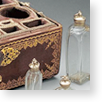
Plato supposed that matter was formed of particles shaped like regular solids. This hypothesis seemed confirmed, in the first half of the 17th century, by microscopic observation of saline crystals, giving rise to a number of new theories on the ultimate structure of matter. Along with the speculative and alchemistic traditions, both medieval and modern chemistry had been characterized by the practice of preparing pharmaceutical remedies by manipulating plants, animals and minerals. The instruments used for these practices were extremely basic, not differing greatly from ordinary kitchen implements.
Bottles
Inv. 3891, 3893
Maker unknown, 18th-19th cent.
Bottles
Inv. 3892, 3894
Maker unknown, 18th-19th cent.
Compound microscope
Inv. 1223
George Adams senior, London, ca. 1770
Glass polyhedron
Inv. 2622
Maker unknown, second half 18th cent.
Glass polyhedron
Inv. 3181
Maker unknown, second half 18th cent.
Glass polyhedron
Inv. 2623
Maker unknown, second half 18th cent.
Matrass with descending still
Inv. 1650
Maker unknown, 18th cent.
Mortar
Inv. 2060
Maker unknown, 18th cent.
Mortars
Inv. 3600
Alessandro Tognozzi (founder), 1764
Portable pharmacy
Inv. 3820
Maker unknown, Tuscany, 18th cent.
Replica of the 14th c. bas relief from Giotto's bell tower illustrating a medical scene
Inv. 3751
Author unknown, 20th cent.




















